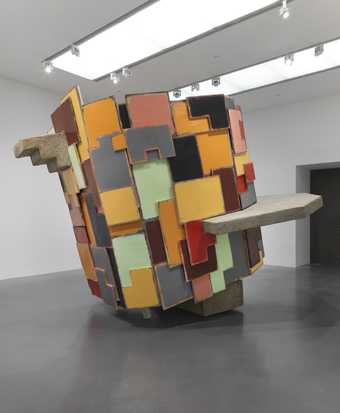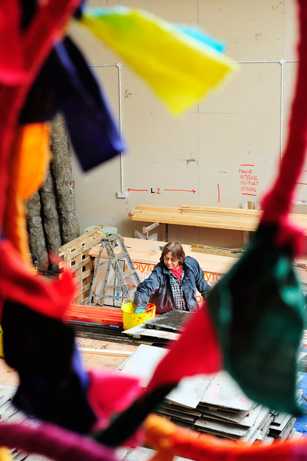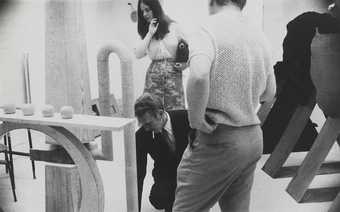
George Fullard and Phyllida Barlow at Chelsea School of Art, c.1967
© the George Fullard Estate, courtesy Gallery Pangolin
The date was 1961. It was a life class and each student was solemnly in attendance of their work. In fact, it was a portrait head class, the silence of such a session being palpable, broken only by the occasional squeaks of the modelling stands as they were turned, the shuffles of the students in their ritualistic movements around their work and the model, and the muffled sounds of the working of the clay: a monastic atmosphere rooted in a tireless history, but repressed and stultified by years of overuse and misuse.
Into this environment entered George, immaculate, brisk, sharp, watchful. He quizzically and shrewdly inspected our tired efforts, moving around the studio with decisive intensity, shadowed by the large, clumsy figure of Lawrence Gowing.
‘Changes need to be made,’ muttered Gowing.
‘Yes,’ responded George, ‘the first being to find out why a head and not a foot.’
This comment, heard by all of us in that studio, including the model, was the alarm that woke us up. We were snapped out of a twilight world, protected by its ceremonies of unquestioned conventions of crafts and skills, and the lights were turned on. In that instant we were given the opportunity to look around and experience the shock of another reality.
Undoubtedly, this brief visit and its portentous overheard conversation precipitated an excitement of almost revolutionary fervour: we were about not only to witness but be part of the end of a regime and the beginning of a new era.
George did not fail us. He far exceeded our wildest expectations initiated by his insistence of his first day that we all convene in the pub, where we remained until closing time, accompanied by the instruction: ‘All talking should take place in the pub, not in the studio,’ followed at a later date by: ‘As artists we should talk a lot, because then anything that can’t be talked about will get made.’
More, much more, was to follow. Worn out processes were revitalised through new descriptions: casting was magical because, like a conjuring trick, an object is made to disappear and then reappear in a completely different material; welding was as facile as sticking with glue and should therefore be used only in an emergency; wood was alive; metal was like paper and could be treated like fabric for dressmaking; and clay was mud. On and on it went, and the maxim of Picasso – ‘before you use a nail, you must reinvent it’ – became the motto by which we all began to exist.
The boundaries were being moved so drastically, and the excitement and energy generated from those movements has, I believe, set a precedent for all who had the good fortune of being there in those early days of George’s association with Chelsea School of Art.
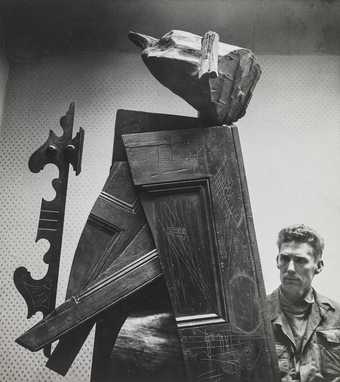
George Fullard and his sculpture Woman with Flowers 1959–60, photographed by Frank Monaco
Photo: Frank Monaco, courtesy Gallery Pangolin
He established that the vision inherent to an art school has to come from within, and not from rules imposed upon it by conventions and dogmas from outside. Such external impositions, he believed, had neither relevance nor accountability from an individual who would be answerable for the kind of tyranny symptomatic of mindless, official authority.
George took total responsibility for his vision. He would never be the mouthpiece for an official stance. The suspicion he had for authority, and its academic influences on art, gave him a youthful vigour. He was an ally of his students, challenging and motivating the vision each young artist possessed, and stripping away the collusion with rote learning which smacked of the academic traits he so loathed and mistrusted.
It is the potent memory that so many of us have of George, of his ability to have given to us through those vivid, demanding, abrasive, contentious, extremely funny, extremely venomous, extremely generous conversations that enabled us to look at the world about us as a rich potential for our own creativity: not to always turn to art, particularly the thoughtless labour of a visionless academic art, for confirmation, but to go elsewhere.
And so he talked of Buster Keaton’s relationships to objects, where Keaton’s absurd, but absolutely familiar, incidents with inanimate things George was able to interpret and to reveal to us as sculptural, and Harold Lloyd’s and Chaplin’s games with accidents as essential information for understanding the accident with a work in progress in the studio, and how to use this and exploit its potential. This was visionary information that has stayed with me, enhanced by further rich revelations: the drama of story telling as with Scott Fitzgerald, how the awkwardness and pathos of the agonising and hopeless relationship described in The Great Gatsby and Tender is the Night was made comparable to the awkwardness of how sculpture gets made and things come together that you never expected to come together. Or, in opposition to this, how seeming clichés within a Bing Crosby or Frank Sinatra song were, in fact, pure poetry, and again, as such were relevant to how we should udnerstand how to use traditional materials of clay, plaster, wood and metal – that the clichés of these materials were there to be manipulated, reinvented, not taken for granted.
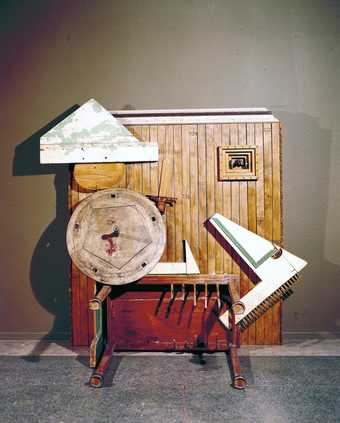
George Fullard
Death or Glory (1963–4)
Tate
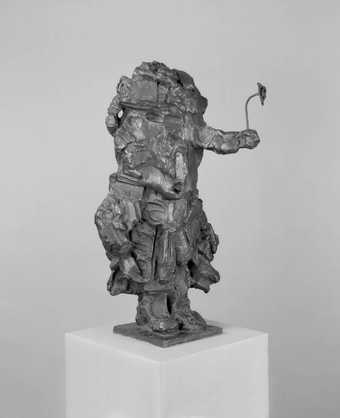
George Fullard
Infant with Flower (1958, cast 1960)
Tate
And there was always more to come: cartoons, like Tom & Jerry, how the cruelty of these characters turned into comedy, a magical and deceptive contrivance that lures and deceives by one means in order to reveal something of another, which, again, every sculptor should be able to achieve.
The resources were limitless, but never predictable, and the focus was never out of sight: the diversity of experiences led to one thing which was able to embrace them all, that was sculpture, and there was always Picasso to prove the point.
George instilled a confidence that proclaimed contradiction as the propagator of creativity; by turning your back on what you were meant to be doing and looking elsewhere, you would find the clues for what you were really meant to be doing:
‘Hard work is disastrous unless you are either exhausted or do not know what you are doing,’ and ‘Draw very late at night when you are exhausted and then you will only draw what is really important.’ Such memories of George confirm that Playing with Paradox (the title of his wonderful exhibition at the Mappin Gallery, Sheffield, in 1998) is a succinct definition of how George worked as an artist and how that informed his teaching, that the two were together, or as he would constantly remind us: ‘You cannot be a teacher as an artist, because you do not know what to teach because everything changes. Memory and trying to remember is all we have.’

